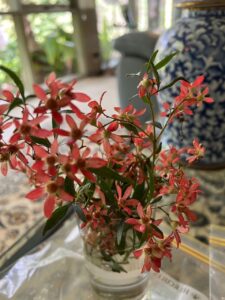WORLD ENVIRONMENT DAY ISN’T ALL DOOM & GLOOM – POSITIVE HAPPENINGS
THE NEW BUSH
We all love the Bush. Twisted gum trees, gorgeous golden wattles and rocky hillsides. But, like it or not, that may not be the “bush” any more. The New Bush is a conglomeration of clotheslines, lawns, verandas, garages, sheds, shopping centres, roads, cars, fish ponds, guttering, drain pipes, windows, weeds and a thousand other man-made objects or plants.
It is in this New Bush that frogs, lizards, birds, possums, spiders and insects live. While some scientists are warning about global warming being a threat to animals and plants, this is a drop in the bucket compared to the incredibly rapid changes from the Bush to the New Bush. In most cities and suburbs and on farms, the last two hundred years have seen an avalanche of change: forests have disappeared, rivers have been polluted, creeks piped, seeding grasses are now mown etc.
Animals are colonising houses, adapting to backyards and farms and eating or living in weeds. The world has changed forever. The conservation groups are whinging all the time that this is awful. Why can’t return to a thousand years ago when primeval forests and pristine waters covered the globe? Well we can’t and it isn’t all bad either. Nature is not collapsing in gales of tears; it is getting on with adapting to the new bush. As with all periods of change, some species will die out and others will flourish. So let’s look at the dynamics of change.
Evil Buildings
Above you will notice a willy wagtail feeding three healthy babies. The nest is on a working farm inside a very busy barn on top of a constantly in-use fluorescent light. The nest is made from hair from the farm’s horses and from spider webs from inside the barn. It is also common to see willy wagtails nesting on Hills hoists. Nearby to this nest of wagtails inside the barn a pair of spotted pardalotes raised a nest of babies in a gap between four bales of lucerne hay. Tractors, quad bikes, trucks and trailers roar past all day but the birds didn’t mind.
Other evil buildings shelter swallows, provide nesting sites for mud dauber wasps, provide homes for carpet snakes, goannas and possums. Windows provide homes for spiders and tree frogs live on house walls, in the downpipes and guttering and the extreme athletes of the tree frog world live in toilet bowls. Many species of geckoes live in houses to eat the insects attracted by the lights at night.
Many species of birds use TV antennae to proclaim their territory. Possums are so well adapted that they lift up roof tiles to access roof cavities.
I have seen crimson finches, redheaded finches, diamond firetail finches, pardalotes, rosellas and many other bird species nesting in house walls, under verandas or in roofs.
Cars, Trucks & Roads
Cars and trucks have a significant effect on animals. Cars kill many animals, leading to vast numbers of road kills. Some animals are adapting to fly to the sides of the roads rather than trying to fly away along the road when they see an approaching car. Cars easily outpace a bird, but smart birds like (feral) Indian mynahs casually walk to the side of the road just beyond the car tyres. Smart birds! Other birds go to war with the adversary in the wing mirror. Peewees, butcherbirds and wrens try to kill the peewee or the wren in the mirror. Parrots, cockatoos and other seedeaters feed on roadside grain spillages (wheat etc). Many birds and herbivores (kangaroos etc) feed on the lush plants that grow on the extra rainfall shed by the roads. Many are killed doing it too. Birds of prey also eat road kills, which can lead to their death in a similar fashion.
Some spiders live their entire lives inside wing mirrors or in crevices between car body panels. Perhaps one day they will be known as Traveller Spiders.
Horrible Shops and Hospitals
Shopping centres are the last place you’d expect to see native birds, but rainbow lorikeets now have adapted to roosting in vast numbers in trees amongst shops. They seem to roost almost nowhere else. Their scientific name if they had been recently discovered could well be Trichoglossus westfieldii (native to Westfield shopping centres).
At the Children’s Hospital at Westmead in Sydney native red-rumped grass parrots have been seen replacing feral sparrows and pigeons, eating breadcrumbs and other food scraps. This is a huge breakthrough. It raises hopes that our native birds may well adapt to quite extreme conditions in cities.
Magpies happily live in our suburbs, sharing food dishes with dogs and cats and showering under dripping taps. Sunbirds seem to prefer to nest under carports or near entrances to houses. Smart frogs sit adjacent to garden lights or next to insect zappers.
Many lizards (not just bluetongues) prefer gardens to the bush. Eastern Water Dragons commonly inhabit garden water features and ponds.
They are all inhabiting the New Bush. With a little help from us many species will adapt to this new world. Plant some grevilleas, banksias, kangaroo paws, bottlebrush etc. Put out some seed dishes for finches and parrots. Grow guinea grass, barnyard grass, panic veldt grass, summer grass and winter grass for the finches. Keep a compost heat to provide insects for wrens etc. Put in ponds for frogs and water dragons. Stop using insecticides to help most birds and lizards.
Our native species need time to adapt. They are showing signs of adapting, but they need our help to compete with sparrows, Indian mynahs and their feral mates. The future can be quite positive for many species if we help them over the hump..
By Don Burke



